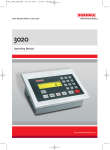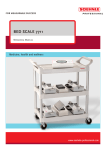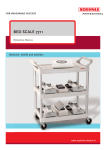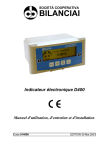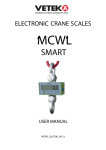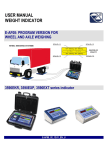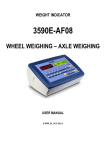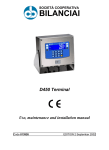Download Soehnle Oxygen Equipment 3010 User's Manual
Transcript
Ba_3010_GB.qxd 03.04.2008 17:06 Seite 1 FOR M EASUREAB LE SUCCESS Basic Terminal 3010 Operating Manual www.soehnle-professional.com Ba_3010_GB.qxd 03.04.2008 17:06 Seite 2 English Contents 1. Introduction . . . . . . . . . . . . . . . . . . . . . . . . . . . . . . . . . . . . . . . . . . . . . . . . . . . ..Page 3 1.1 Operating manual notes . . . . . . . . . . . . . . . . . . . . . . . . . . . . . . . . . . . . . . . . . . .Page 3 1.2 Description of the appliance . . . . . . . . . . . . . . . . . . . . . . . . . . . . . . . . . . . . . . . .Page 3 1.3. Putting into operation . . . . . . . . . . . . . . . . . . . . . . . . . . . . . . . . . . . . . . . . . . . . .Page 4 1.4. Installation . . . . . . . . . . . . . . . . . . . . . . . . . . . . . . . . . . . . . . . . . . . . . . . . . . . . . .Page 4 1.5 Symbols . . . . . . . . . . . . . . . . . . . . . . . . . . . . . . . . . . . . . . . . . . . . . . . . . . . . . . ..Page 5 1.6 Description of the nameplate . . . . . . . . . . . . . . . . . . . . . . . . . . . . . . . . . . . . . . .Page 5 1.7 Control keys . . . . . . . . . . . . . . . . . . . . . . . . . . . . . . . . . . . . . . . . . . . . . . . . . . . .Page 6 1.8 Electronic nameplate . . . . . . . . . . . . . . . . . . . . . . . . . . . . . . . . . . . . . . . . . . . . .Page 7 2.0 Basic functions . . . . . . . . . . . . . . . . . . . . . . . . . . . . . . . . . . . . . . . . . . . . . . . . . .Page 8 2.1 Power-on . . . . . . . . . . . . . . . . . . . . . . . . . . . . . . . . . . . . . . . . . . . . . . . . . . . . . .Page 8 2.2 Switching off . . . . . . . . . . . . . . . . . . . . . . . . . . . . . . . . . . . . . . . . . . . . . . . . . . . .Page 8 2.3 Zeroing . . . . . . . . . . . . . . . . . . . . . . . . . . . . . . . . . . . . . . . . . . . . . . . . . . . . . . . .Page 8 2.4 Switching over the weight unit kg <> lb . . . . . . . . . . . . . . . . . . . . . . . . . . . . . . .Page 8 2.5 Taring function . . . . . . . . . . . . . . . . . . . . . . . . . . . . . . . . . . . . . . . . . . . . . . . . . .Page 9 2.6 Ten times resolution X10 . . . . . . . . . . . . . . . . . . . . . . . . . . . . . . . . . . . . . . . . . .Page 10 2.7 Switching over the scales (measuring points) 2.8 Alibi memory . . . . . . . . . . . . . . . . . . . . . . . . . . . . . . . . . . . . . . . . . . . . . . . . . . .Page 10 2.9 Hold function . . . . . . . . . . . . . . . . . . . . . . . . . . . . . . . . . . . . . . . . . . . . . . . . . . .Page 11 . . . . . . . . . . . . . . . . . . . . . . . . .Page 10 2.10 Measuring point inputs and outputs . . . . . . . . . . . . . . . . . . . . . . . . . . . . . . . . ..Page 12 2.11 3.0 4. 2 LED lamps . . . . . . . . . . . . . . . . . . . . . . . . . . . . . . . . . . . . . . . . . . . . . . . . . . . . .Page 12 Application programs . . . . . . . . . . . . . . . . . . . . . . . . . . . . . . . . . . . . . . . . . . . .Page 13 3.1 Weighing and taring . . . . . . . . . . . . . . . . . . . . . . . . . . . . . . . . . . . . . . . . . . . . . .Page 13 3.2 Counting . . . . . . . . . . . . . . . . . . . . . . . . . . . . . . . . . . . . . . . . . . . . . . . . . . . . . ..Page 13 3.3 Totalising . . . . . . . . . . . . . . . . . . . . . . . . . . . . . . . . . . . . . . . . . . . . . . . . . . . . . ..Page 14 3.4 Batching 3.5 Withdrawal weighing . . . . . . . . . . . . . . . . . . . . . . . . . . . . . . . . . . . . . . . . . . . . .Page 15 3.6 Switching point programming . . . . . . . . . . . . . . . . . . . . . . . . . . . . . . . . . . . . . . .Page 16 3.7 Checking . . . . . . . . . . . . . . . . . . . . . . . . . . . . . . . . . . . . . . . . . . . . . . . . . . . . . .Page 16 3.8 Dosing. . . . . . . . . . . . . . . . . . . . . . . . . . . . . . . . . . . . . . . . . . . . . . . . . . . . . . . . .Page 16 . . . . . . . . . . . . . . . . . . . . . . . . . . . . . . . . . . . . . . . . . . . . . . . . . . . . . .Page 15 Troubleshooting . . . . . . . . . . . . . . . . . . . . . . . . . . . . . . . . . . . . . . . . . . . . . . . . .Page 18 Ba_3010_GB.qxd 03.04.2008 17:06 Seite 3 English Thank you for choosing this Soehnle Professional product. All the features of this product were designed to the state of the art and are optimised for simple and straightforward use. If you have any queries or experience any problems with the appliance that are not addressed in the operating instructions, please contact your Soehnle Professional service partner or visit us on the web at www.soehnle-professional.com. 1.1 Operating manual notes This operating manual describes all the standard functions and settings of the Basic Terminal 3010. Further information on the Setting mode is provided on the enclosed CD. All the information is based on the standard version of the Basic Terminal 3010. There may be deviations on special-purposes versions. 1.2 Appliance description Technical data • Housing made of stainless steel, protection class IP 40 or 65, integrated power adapter 100 - 240 VAC, optional DC/DC converter, 12 or 24 V • 2 measuring points connectable internally • Membrane keyboard with a total of 10 keys, 1 function key • Display: 7 digits, 7-segment display, 16 mm digit height, backlit and dimmable • Operating temperature: -10°C to +40°C • Calibratable to Precision Class III for n = 8000e for multirange and multidivision scales. • Approvable weighing range 0.1 kg to 120 t. • Smallest permissible input signal per calibration value = 0.22 µV. • Load cell power supply 5 VDC Optional: • Alibi memory for min. 2 million inputs • Interfaces: 2 x RS 232, additional ports optional, including bus, analogue output 0 - 20 mA, USB 3 Ba_3010_GB.qxd 03.04.2008 17:06 Seite 4 English 1.3 Putting into operation Before connecting the power plug to the mains, make sure that the power supply specified on the nameplate and the power plug version comply with local conditions. Place the connected scales on a level and stable surface. Protect the application by selecting a site of installation that is not subject to shocks, vibration, intensive heat or cold, draughts, chemicals or moisture. The appliance may only be opened by trained service technicians. Before carrying out any service work on the appliance, disconnect the power supply. After power-on, the measured values stabilise after a warm-up period of 30 minutes. Pressure compensation membrane on IP 65 housing Power supply Interface 1 Ground (GND) Interface 2 Scale 1 + 2 Connections e.g. Profibus, Ethernet, etc. 1.4 Installation Install the weighing platform at the point of use. Using a spirit level and the adjustable feet, ensure that the platform is horizontal. Install the Basic Terminal or mount it on the wall using the optional bracket. Provide access to a mains power source or connect the appliance to a DC power source using a DC/DC converter. The scale is ready for use. 4 Ba_3010_GB.qxd 03.04.2008 17:07 Seite 5 English 1.5 M1 Symbols Active measuring point (scale) Active weighing range Zero reading Net weighing Tare reading Manual tare Hold mode (The reading is fixed to improve legibility) Total memory Piece count mode Alibi memory O1-O4 1.6 Switching points (Outputs O1 - O4) Description of the nameplate Weighing ranges Maximum load of weighing range Minimum load of weighing range Calibration value (resolution) Serial number of scale (scale type, last digits of year of manufacture, consecutive number) EU conformity mark with year of affixing also start of validity of verification Precision class D07-09-011 Number of EU approval XXXX e.g. 0103, Official Code of "Notified Body" (this body performed the initial calibration) M Symbol for EU calibration Calibration counter status 001 Max Min e= SNR XXXX 5 Ba_3010_GB.qxd 03.04.2008 17:07 Seite 6 English 1.7 Control keys Operating mode Setpoint input Setting mode On / Off Zeroing key or Clear tare Set input to zero Tare key Increment value Next setting step or increment value Next setting step or increment value Access edit function within setting step or save parameter and go to next setting step Print key or Enter key Clear key or Cancel key One menu level back, or shift an editable decade from right to left Cancel key Go back one menu level in Setting mode Info key Totalise or Batch Count 6 Setpoints or corrected values Accept setpoints or corrected values and continue. Freely programmable function key Decrement value Go back by one setting step or decrement value Ba_3010_GB.qxd 03.04.2008 17:07 Seite 7 English 1.8 Electronic nameplate Press the Info key twice to display the electronic nameplate. Press the arrow keys ( / ) to indicate the electronic nameplate, the Serial No. and the calibration counter of the activated measuring points in the display. Press the CL key to cancel or end display of the electronic nameplate. With a 1 or 2-range scale, the parameters of the other ranges disappear. Display step Parameter 1. - 2. Calibration counter 3. Type 4. Year 5. Serial No. 6. ID Chip 7. Max of Range 1 8. Min of Range 1 _ 0,20kg and symbol for Range 1 9. e of Range 1 E 0,01kg and symbol for Range 1 10. Max of Range 2 ¯ 20,00kg and symbol for Range 2 11. Min of Range 2 _ 0,40kg and symbol for Range 2 12. e of Range 2 E 0,02kg and symbol for Range 2 13. Max of Range 3 ¯ 30,00kg and symbol for Range 3 14. Min of Range 3 _ 1,00kg and symbol for Range 3 15. e of Range 3 E 0,05kg and symbol for Range 3 Reading ¯ 10,00kg and symbol for Range 1 On a non-approved scale, "d" is displayed instead of "E". 7 Ba_3010_GB.qxd 03.04.2008 17:07 Seite 8 English 2. Basic functions The basic functions are similar or identical for all application programs. 2.1 Power-on Only when the scale is not loaded. After the test routine, the display is set to zero. The scale is ready for use. Place the weighing product on the scale. The display shows the gross weight. 2.2 Switching off This is immediately possible when the display is "0". Otherwise hold down the key for 3 seconds. 2.3 Zeroing Press the Zeroing key to correct minor deviations from zero, e.g. caused by soiling on the scale. Zero range approvable and non-approved: -1% to +3% of the weighing range. 2.4 Switching over the weight unit kg <> lb The option for switching over the weight units must be released in Calibration mode. Switch over by pressing the Info key and then the Zeroing key. If weight unit switchover was also assigned to the F key in Setting mode, you can also switch over the unit by pressing the F key. 8 Ba_3010_GB.qxd 03.04.2008 17:07 Seite 9 English 2.5 Taring function Manual tare Place an empty container on the platform and press the -key. Manual tare input In Setting mode (see separate description 470.702.078 User Mode), select "Manual tare input" to assign the key. Then in operation, press the -key to set the value using the arrow keys ( / ). The set value is accepted by pressing the -key. Tara info Press the -key and then the - key to display the currently stored tare value. Press the CL key to exit the display. Clear tare Press the -key or the - and - keys in succession. Autotare function Tares the first weight value on the scale automatically. Place an empty container on the platform. When the platform is still, the first weight value in the tare memory is accepted. After clip off, the tare memory is cleared automatically. The Autotare function must be selected in Setting mode (see separate description 470.702.078 User Mode). Provisional tare function A provisional tare function can be assigned to the -key (see separate description 470.702.078 User Mode). Unknown tare values can be added to the existing tare value without changing the net reading. Press the -key. "Hold" appears in the display. Place additional tare on the platform or remove tare from the platform. Press the -key to accept the new tare value. 9 Ba_3010_GB.qxd 03.04.2008 17:07 Seite 10 English 2.6 Ten times resolution X10 The ten times resolution appears by pressing the simultaneously. -key and the Zeroing key On approved scales, the high resolution appears for 5 seconds or flashes as long as you hold down the keys - on non-approved scales, the high resolution appears as long as you press the -key and the Zeroing key. wird. 2.7 Switching over the scales (measuring points) The Basic Terminal 3010 can operate 2 analogue measuring points. Toggle between the measuring points by pressing the INFO key followed by the -key (in succession). 2.8 Alibi memory The alibi memory is activated in Setting mode (see separate description 470.702.078 User Mode). When the alibi memory is activated, an arrow points to the corresponding symbol. The arrow flashes as soon as the entered limit for full indication is reached. Press the -key or data request to accept a value to the alibi memory. To do this, the print template or the data record must be configured accordingly (see separate description 470.508.059 Data Interface). Send a request to the alibi memory (view/print entries) in Setting mode: Press Press Press the - and -key repeatedly until UCAL I appears. UCAL 5 appears. -key to confirm. Then press the Press the -keys for 5 seconds until -key until the Setting step 03 appears. -key to confirm. The number of the last data record saved appears. Call each data record by changing the consecutive number using the arrow keys ( / ) and display by confirming with the -key. 10 Ba_3010_GB.qxd 03.04.2008 17:07 Seite 11 English The selected data record is displayed in scroll mode as follows: Display Meaning I2 Consecutive number of alibi entry 2880 Scale type 07 Year 000I Consecutive number A I2,34 kg A 2,98 kg Serial number of measuring point Gross or net with alibi ID T Tare with alibi ID Scroll by pressing the arrow keys ( / ) up or down. Quite the View mode by pressing the -key. Press the -key and then hold down the - and - keys for 5 seconds to switch back to Weighing mode. 2.9 Hold function The hold function is activated in Setting mode (see separate description 470.702.078 User Mode). In weighing mode, activate the Hold function by pressing the F key. The following Hold functions are standard on the Digital Indicator Type 301x to freeze weight data. Default is "0". Hold mode Function Clear function 0 Not active 1 Hold at standstill On key 2 Hold at standstill Clip off 3 Max. value On key 4 Max. value Clip off 5 Slave counter On key 6 Slave counter Clip off 11 Ba_3010_GB.qxd 03.04.2008 17:07 Seite 12 English 2.10 Inputs and outputs The optional I/O module has 4 inputs and outputs that can be individually configured in Setting mode (see (separate description 470.702.078 User Mode). 2.11 LED lamps The appliance has integrated LED lamps. The functionality can be set and activated individually for each application program in Setting mode (see separate description 470.702.078 User Mode). 12 Ba_3010_GB.qxd 03.04.2008 17:07 Seite 13 English 3.0 Application programs The various application programs on the Soehnle Basic Terminal 3010 offer you a wide range of solutions for weighing operations. You can modify the application programs to your specific requirements in Setting mode (see separate description 470.702.078 User Mode). Below is a list of application programs available to you: 3.1. Weighing and taring 3.2. Counting 3.3. Totalising 3.4 Batching 3.5 Withdrawal weighing 3.6. Switching point programming 3.7. Checking 3.8 Dosing 3.1 Weighing and taring Weighing The appliance starts in Weighing mode after power-on. Place weighing product on platform and read weight Weighing with tare Refer to 2.5. An active tare weight is indicated by the letter "N" appearing in the display. 3.2 Counting The counting function is activated by pressing the Counting key. The message "Add XXX" (XXX=number of reference parts) requests you to place one or several reference parts on the platform. By pressing the Counting key repeatedly, you can change the reference quantity for lightweight reference parts in steps of 1/2/5/10/25/50. Place the reference parts on the platform and confirm by pressing the -key. Then place the countable parts on the platform and read off the countable parts. Change to Weighing mode by pressing the CL key. Counting with tare Refer to 2.5. An active tare weight is indicated by the letter "N" appearing in the display. 13 Ba_3010_GB.qxd 03.04.2008 17:07 Seite 14 English Displaying the piece weight Press the Info key and then the counting key to display the piece weight. Press the CL key to go back. 3.3 Totalising Place weighing product on the platform in Weighing mode and accept the weight value in the total memory by pressing the + key. Remove the weighing product from the platform or - dependent on the previous setting - clip off. In Setting mode (see separate description 470.702.078 User Mode), define whether the scale must be clipped off each time you place an individual piece on the platform by increments of 1 to 30. If the scale is not clipped off, the weight unit is not accepted in the total memory. This prevents operations such as saving an item twice. Place the next weighing product on the platform and press the + key to accept the weight value in the total memory, etc. A full total memory is recognised by the totalising character (Σ). Call up the total value by pressing the Info key and then the + key. The display then scrolls: Gross, Tare, Net and Quantity. Cancel or end by pressing the CL key. Clear the total memory by pressing the CL key and then the + key. Totalising with tare Refer to 2.5. An active tare weight is indicated by the letter "N" appearing in the display Autototalising (select function in Setting mode) Place weighing product on the platform in Weighing mode and accept the weight value in the total memory by pressing the + key. Remove weighing product from the platform. Place the next weighing product on the scale. The weight value is automatically accepted in the total memory. Remove the weighing product from the platform and place the next weighing product, etc. Carry out a complete configuration of the totalising functions in Setting mode (see separate description 470.702.078 User Mode). 14 Ba_3010_GB.qxd 03.04.2008 17:07 Seite 15 English 3.4 Batching Place weighing product on the platform in Weighing mode and accept the weight value in the batch memory by pressing the + key. Place the next weighing product on the platform and press the + key to accept the weight value in the batch memory, etc. A full batch memory is recognised by the totalising character (Σ) in the display. Call up the total value by pressing the Info key and then the + key. The display then scrolls: Gross, Tare, Net and Quantity. Cancel or end by pressing the CL key. Clear the batch memory by pressing the CL key and then the + key. Batching with tare Refer to 2.5. An active tare weight is indicated by the letter "N" appearing in the display. Autobatching (select function in Setting mode) Place weighing product on the platform in Weighing mode and accept the weight value in the batch memory by pressing the + key. Place the next weighing product on the scale. The weight value is automatically accepted in batch memory.Place the next weighing product on the scale, etc. Carry out a complete configuration of the batching function in Setting mode (see separate description 470.702.078 User Mode). 3.5 Withdrawal weighing Place a container with the weighing product on the platform. Press the tare key. Remove part of the weighing product. The removed weight value is displayed with a negative sign. Press the tare key again, etc. 15 Ba_3010_GB.qxd 03.04.2008 17:07 Seite 16 English 3.6 Switching point programming Four switching points can be set in the Basic Terminal 3010. The switching points are used for switching and dosing. Setting the switching points Press the switching point key. The first switching point is displayed. This is indicated by the arrow in the display. Set the value using the arrow keys ( / ). The value is incremented individually by tapping the key briefly. When you hold the key down, the display increments or decrements continuously. Acknowledge by pressing the -key. The display jumps to the next switching point. Set the value using the arrow keys ( / ). Press the -key to confirm, etc. Each switching point function is defined in Setting mode (see separate description 470.702.078 User Mode). 3.7 Checking The switching points for the internal LED lamps or the external lamps (optional) are used for checking. Enter the setpoints as check values as follows. Switching point Value S1 0 S2 Lower tolerance S3 Upper tolerance S4 Upper tolerance Enter the switching points as described in 3.6. Activate in Setting mode (470.702.078 User Mode). 3.8 Dosing The following dosing functions can be set: • Coarse dosing without correction value + fine dosing without correction value • Coarse dosing with correction value + fine dosing with correction value • Coarse dosing without correction value + fine dosing with correction value • Fine dosing without correction value • Fine dosing with correction value 16 Ba_3010_GB.qxd 03.04.2008 17:07 Seite 17 English Select the dosing function in Setting mode (see separate description 470.702.078 User Mode and 470.051.109 Dosing). Use the switching points (see 3.6) to set coarse flow, fine flow and correction value. Setting the switching points S1 Setpoint for coarse dosing S2 Setpoint for fine dosing S3 Correction value for coarse dosing S4 Correction value for fine dosing The greatest possible switching point in the maximum scale load. Dosing operation Tare the container as required. Note: A dosing start interlock with an untared scale must be selected in Setting mode (see separate description 470.702.078 User Mode). Start the dosing function by pressing the F key. The dosing valve open and dosing product flows. The yellow LED lights up and the display flashes until the set dosing weight is reached. The green LED lights up when the dosing weight is reached and is within the tolerances. The dosing valve closes. The red LED lights up when the upper dosing weight tolerance is exceeded. Interrupting the dosing operation Press the CL key. The yellow LED lights up, the display flashes and waits for the dosing operation to continue (the same response takes place when the dosing product is not sufficient for a full dosing operation). Press the F key to continue the dosing operation. The dosing operation is also interrupted when the scale is in overload or underload. When the overload or underload condition is remedied, the dosing operation continues automatically. Ending the dosing operation Press the CL key twice. The scale is then in standard weighing mode. Dosing with totalising function The totalising function during dosing must be selected in Setting mode (see separate description 470.702.078 User Mode). Presetting: NO totalising. 17 Ba_3010_GB.qxd 03.04.2008 17:08 Seite 18 English 4 Troubleshooting Display Remedy Please check that you operated the appliance correctly. If not, interrupt the command chain by pressing the CL key. The scale sets the value zero automatically when it is switched on. If the scale is outside the set tolerance band, the display indicates --0--. Clip off the platform. Possibly remove any soiling. If the scale fails to display zero after a few seconds, please inform your service partner Underload: Only the lower horizontal Switch off the scale and switch it lines appear in the display pane. back on again. The zero point is reset automatically Overload: Only the upper horizontal Remove part of the weighing product lines appear in the display pane. The from the scale. maximum weighing range is exceeded. Part weight too small. Zeroing limit overshot or undershot. Not possible to tare an unloaded scale; not possible in overload. Not possible to print in underload or overload. Switchover kg/lb locked. In case of other error messages, please contact your service partner. 18 Ba_3010_GB.qxd 03.04.2008 17:08 Seite 19 English 19 Ba_3010_GB.qxd 03.04.2008 17:08 Seite 20 Printed in Germany 04/2008 Subject to technical modifications FOR M EASURAB LE SUCCESS Soehnle Professional GmbH & Co. KG Phone Fax E-Mail 470.051.104 GB Wilhelm-Soehnle-Straße 2 71540 Murrhardt +49 (0) 71 92 / 93 19-220 +49 (0) 71 92 / 93 19-211 [email protected] Scales, System Solutions and Special Developments www.soehnle-professional.com




















